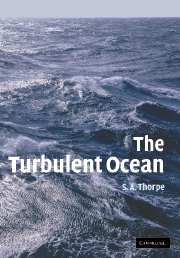Book contents
- Frontmatter
- Contents
- Preface
- Structure and résumé
- Acknowledgements
- 1 Heat, buoyancy, instability and turbulence
- 2 Neutral stability: internal waves
- 3 Instability and transition to turbulence in stratified shear flows
- 4 Convective instabilities
- 5 Instability and breaking of internal waves in mid-water
- 6 The measurement of turbulence and mixing
- 7 Fine-structure, transient-structures, and turbulence in the pycnocline
- 8 The benthic boundary layer
- 9 The upper ocean boundary layer
- 10 Shallow seas
- 11 Boundary layers on beaches and submarine slopes
- 12 Topographically related turbulence
- 13 Large-scale waves, eddies and dispersion
- 14 Epilogue
- Appendices
- References
- Index of laboratory experiments
- Subject index
- Plate section
3 - Instability and transition to turbulence in stratified shear flows
Published online by Cambridge University Press: 05 June 2012
- Frontmatter
- Contents
- Preface
- Structure and résumé
- Acknowledgements
- 1 Heat, buoyancy, instability and turbulence
- 2 Neutral stability: internal waves
- 3 Instability and transition to turbulence in stratified shear flows
- 4 Convective instabilities
- 5 Instability and breaking of internal waves in mid-water
- 6 The measurement of turbulence and mixing
- 7 Fine-structure, transient-structures, and turbulence in the pycnocline
- 8 The benthic boundary layer
- 9 The upper ocean boundary layer
- 10 Shallow seas
- 11 Boundary layers on beaches and submarine slopes
- 12 Topographically related turbulence
- 13 Large-scale waves, eddies and dispersion
- 14 Epilogue
- Appendices
- References
- Index of laboratory experiments
- Subject index
- Plate section
Summary
Introduction
How turbulence develops from the instability of a smooth, laminar, stably stratified, shear flow is described in this chapter. It commences with an account of the early history of the study of the instability and how it was eventually observed in the ocean. The story nicely illustrates how the study of fundamental processes in fluid dynamics aids the investigation of naturally occurring fluids, in this case first the atmosphere and later the ocean and lakes. The shear flow instability involves several features characteristic of turbulent flow: the formation of eddies, the stretching of fluid between neighbouring eddies – intensifying gradients of fluid properties, notably density – their pairing or amalgamation and the transfer of vorticity to larger scales, and their break-down to form an energetic field of smaller eddies. Shear instability is by no means the only form of instability to occur in the stratified ocean, as is revealed in later chapters.
The temperature measurements that were to form the basis of Watson's discovery of internal seiches in Loch Ness, described in Section 2.1, and which underpinned Wedderburn's later investigations, began in April 1903, using reversing thermometers. Measurements were made at about ten depths on a roughly daily basis. Wedderburn (1907) reports the following, using the Germanic ‘Sprungschicht’ to mean a layer of changing temperature or density.
The behaviour of water in the neighbourhood of a Sprungschicht is very similar to the behaviour of water near the surface. Before this was understood, the observers were often puzzled when working with mercury thermometers by obtaining readings which seemed to show the presence of very marked inverse stratification, which always disappeared in a very illusory fashion when any attempt was made to follow it up.
- Type
- Chapter
- Information
- The Turbulent Ocean , pp. 80 - 114Publisher: Cambridge University PressPrint publication year: 2005
- 1
- Cited by



